Tomato Pasatta
- Pickles, Chutney, Relish & Sauces
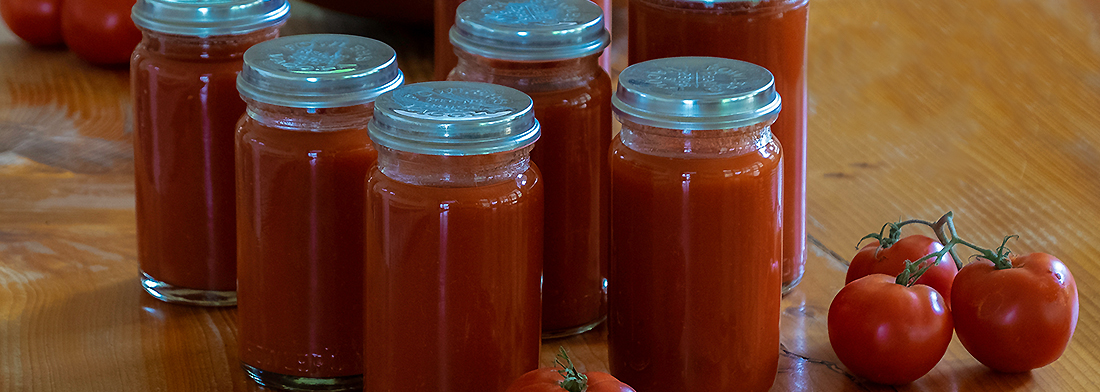
Capture the essence of summer ripened tomatoes in this traditional Italian passata recipe. Three ingredients - tomatoes, basil and salt and three steps - pulp, bottle and preserve and store. Its intensity and vibrancy stand proud in the pantry and it’s the centre of many of Italy’s favourite dishes so revered around the world. It can be rustic and chunky or silky depending upon the equipment used, but it must always have a rich red colour, the dense consistency of pulped not liquidised tomatoes and a fresh vibrant flavour.
Passata is different to sugo. Passata is uncooked whereas sugo, in its simplest form, is a cooked tomato sauce with onions, garlic and seasoning. Passata is often used as the base for a sugo. This recipe details two different methods to pulp and preserve the tomatoes as not everyone has a food mill and preserving unit.
Start your own Passata Day ritual and reap the rewards through the year of having a majestic bottle of goodness that adds love, life and lusciousness to your family meals.
- Preparation Time:
- 45 minutes
- Cooking Time:
- 30 minutes
- Quantity:
- 4 x 500 ml bottles
INGREDIENTS
- 4kg
- Ripe red tomatoes
- 1 per bottle
- Individual basil leaves - washed
- 1.5 tablespoons
- Salt
METHOD
The following method outlines the 3 basic steps of passata:- making a skinless and seedless tomato pulp, which can be done by hand or a food mill
- bottling and sealing
- preserving for longer term storage
If making passata is an annual ritual, a food mill is highly recommended as it separates the skin and seeds while pulping the tomatoes. Your passata day will be more enjoyable with a little mechanical help.
A food mill could be a mouli (French version) or passa verdura (Italian equivalent), a tomato press or specialised attachment to a KitchenAid or equivalent. The traditional passata consistency, a rich dense sauce, is obtained by using a food mill.
An alternative method is to manually skin and peel the tomatoes then pulp using a food processor or finely chop by hand. Vitamising the tomatoes at this stage is not recommended as it will aerate the sauce and produce a very different texture.
Instructions for both methods are detailed below.
Make Skinless & Seedless Tomato Pulp
The tomato pulp can be made by hand or using a food mill.
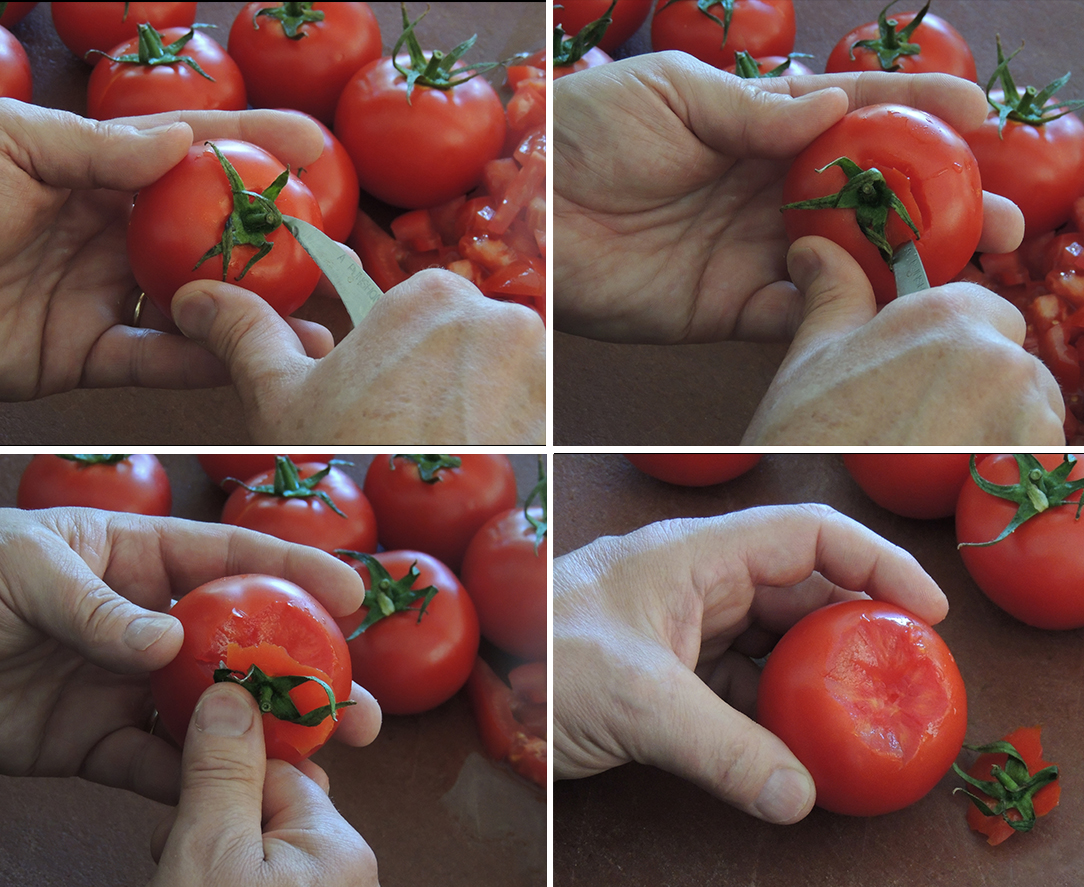
Manual Method to Peel & Seed Tomatoes
Insert a small sharp vegetable knife a short distanced from the stem. Using as slight inward angle, cut in a circular motion all the way around the stem. Remove any blemishes. Repeat the process until all the tomatoes have been prepared.
Place several tomatoes at a time in a pot of continuously boiling water for approximately 20 seconds. Remove and place in bowl of cold water when the skin has just begun to blister or shrivel. This will soften the skin for the next step. Do not overcook at this point.
Peel the skin off and discard. If a tomato is difficult to peel, place back in the boiling water for a few more seconds. If tomatoes are under ripe, they can be difficult to peel even after their hot water bath.
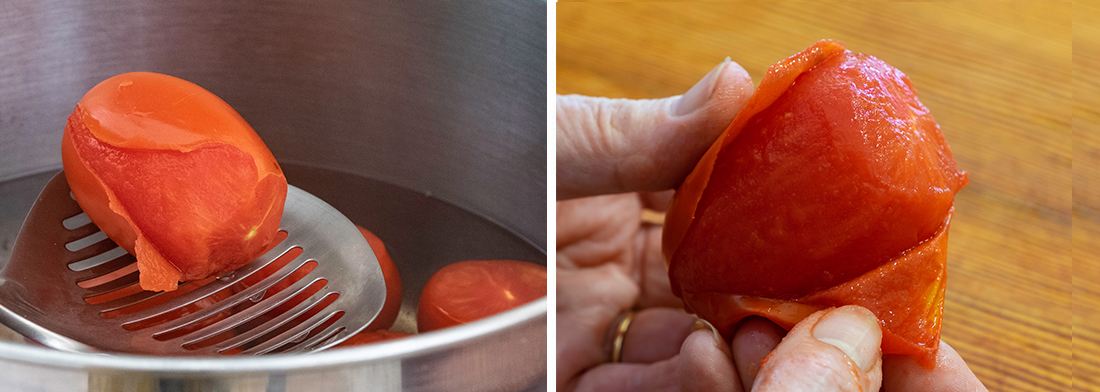
Place a fine strainer over a bowl. Cut the tomato in half and gently squeeze over the strainer to release all the seeds. Place the tomatoes in a large bowl for later use. Repeat the process until all tomatoes have been peeled and seeded.
Roughly chop the tomatoes, place in a food processor to pulverise or finely chop by hand.
Reserve the pulpy juice and add the salt. Discard the skin and seed mass.
Mouli or Passa Verdura Method to Peel & Seed Tomatoes
If using a mouli or pass verdura, place it over a bowl to catch the pulpy juice. Follow step 1 and 2 in the above method to prepare and blanch the tomatoes so the skin is easily removed by the food mill. If the tomatoes are large, roughly chop and add the blanched tomatoes and turn the handle continuously to separate the juice and pulp from the seeds. Reserve the pulpy juice and add the salt. Discard the seed mass.
You may need to empty the strainer from time to time as the seed mass accumulates and interferes with the separation process. Give the mass a second run-through, if necessary, to ensure you extract as much flesh and juice as possible. This step will enhance the flavour and increase the pulp yield.
Once all the tomatoes have been processed proceed to Step 2 : Bottle the Passata.
Tomato Press or Food Strainer Method to Peel & Seed Tomatoes
If using as an attachment on your KitchenAid (food strainer) or equivalent or a tomato press, core the tomatoes as outlined in Step 1 Manual Method to Peel & Seed Tomatoes. Then place the tomatoes in the attachment and process according to the instructions. Reserve the pulpy juice and add the salt. Discard the seed mass.
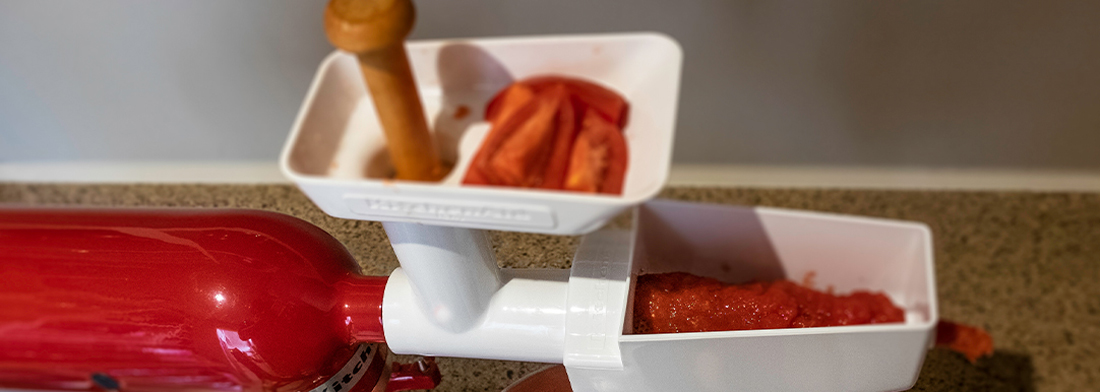
You may need to empty the strainer from time to time as the seed mass accumulates and interferes with the separation process. Give the mass a second run-through, if necessary, to ensure you extract as much flesh and juice as possible. This step will enhance the flavour and increase the pulp yield.
Once all the tomatoes have been processed proceed to Step 2 : Bottle the Passata.
BOTTLE THE PASSATA
Place the washed basil leaf in the bottom of each prepared sterilised bottle. The basil flavour will be infused in the passata as it stores.
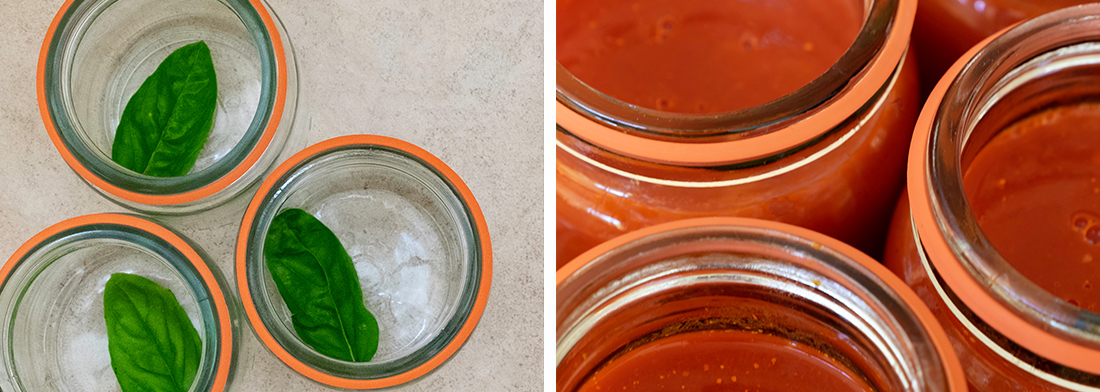
Using a jug and/or funnel pour in the passata leaving a 3-4 cm gap from the top of the lid.
Close bottles in accordance with the type of bottle/jar sealing method used.
PRESERVING THE PASSATA
Use either the Preserving Unit Method or the Stock Pot Method. The principles are the same. The difference is a preserving unit will have an internal removable rack for bottles to sit on and a tap to easily draw off the water. Some units may have an in-built thermometer.
Preserving Unit Method
Place sealed bottles/jars in Fowlers Preserving Unit (link) or equivalent.
Cover with water, bring to the boil and hold at gentle boil for 30 minutes.
Turn off, remove lid and allow to stand for 5 minutes before removing.
Using the tap draw off some of the hot water so the level is sufficiently below the bottles to be able to safely remove them without scalding yourself.
Remove from hot water bath and place on a board to cool.
Stock Pot Method
Line large stock pot with some sheets of newspaper or a cut-down cake rack. Place the bottles on the newspaper or rack, in the pot, allowing space between each bottle so they don’t touch. This lining will protect the bottles from direct heat and prevent cracking.
Cover with water, bring to the boil and hold at gentle boil for 30 minutes.
Turn off, remove lid and allow to stand for 5 minutes before removing.
If possible, remove some of the hot water so the level is sufficiently below the bottles to be able to safely remove them without scalding yourself.
Remove from hot water bath and place on a board to cool.
STORING
Label and store in a cool dark place in the kitchen or pantry
Once opened, keep in the fridge and use within a week.
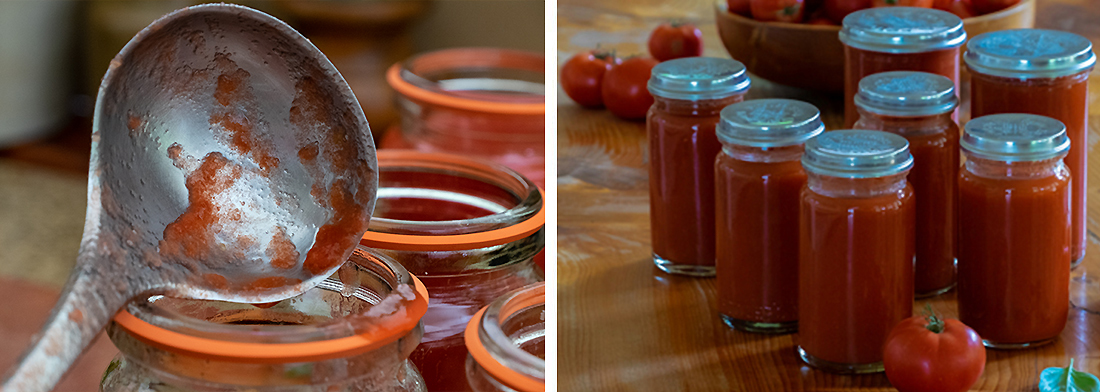
NOTES
- Vine ripened red tomatoes make the best passata. Colour and flavour come from both the juice and skin so allowing them to develop their full flavour and colour potential on the vine will produce a more intense passata.
- If using home-grown tomatoes allow them to colour-up and develop their full flavour and you’ll be rewarded by a majestic tomato flavoured passata. If using store bought tomatoes that haven’t been vine ripened, allow them to ripen as much as possible before use. The flavour will not be as intense but will be better than using only partially ripe tomatoes.
- When making large quantities, the acidity in the tomatoes may aggravate sensitive skin. This can be prevented by using disposable food handling gloves.
- When filling bottles or jars, leave a 3-4 cm gap. Allowing room for, the passata to expand while boiling will prevent the lids from blowing off.
- Salt is used as a seasoning and helps to preserve the passata.
- A blender or vitamiser is not recommended as it will liquify the sauce, produce a bitter flavour from the seeds and significantly change the consistency of the final passata.
- Variation Roasted Passata. Roast the tomatoes in a pan first. This will intensify the flavour and colour. Allow to cool before putting through a food mill. Bottle and store as the methods outlined above.
